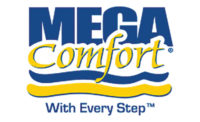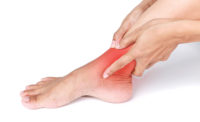However, not all entryway mats are the same. Some mats are more effective than others when it comes to capturing and trapping soils and moisture. There are also a variety of matting types, including bi-level mats, wiper mats and wiper/scraper mats. Further, entry mats must be installed correctly, typically by using a system known as the “Rule of 15.”*
The Rule of 15* refers to the effective placement of matting both in and outside of a facility. First, five feet of scraper mats are placed outside the facility to scrape off large debris. Five feet of wiper/scraper mats are installed directly inside the facility as the next line of defense. Finally, five feet of a third type of mat, known as a wiper mat, is placed in the lobby area itself. Working together, these three kinds of matting form a system that can keep more than 70 percent of moisture and contaminants from being walked into a facility.
Anti-fatigue mats
Just as not all entry mats work the same way, not all anti-fatigue mats produce the same results. In fact, while most plant managers are aware of these products and their purpose, anti-fatigue mats can prove to be more confusing and harder to understand than any other type of matting.
Anti-fatigue mats, as the name implies, are designed to cut down on fatigue for those working in a standing position for prolonged periods of time. These products allow the user to make “micro-movements” while standing, which can reduce back and foot pain, fatigue, and physical stress. Additionally, they help enhance blood and oxygen flow through the lower limbs, which also reduces fatigue. Studies have indicated that people are more likely to have or cause an accident when they are tired, in pain, or fatigued — meaning these mats can also potentially reduce injuries to both standing workers and others in a facility.
Anti-fatigue mats can be made with vinyl, wood, PVC and PVC tubing, rubber, foam, polypropylene, nitrile rubber, or other materials. While they are frequently found in manufacturing and industrial locations where staff must stand for the majority of their working day, food service facilities, cashiers, and beauty shops frequently make use of these products as well. After all, these workers are typically on their feet eight to ten hours per day, and often suffer the same fatigue and pain caused by long standing with which industrial workers are all too familiar.
A bit of history
It is believed the first anti-fatigue mats were introduced more than 30 years ago. Since then, other manufacturers have introduced their own lines of anti-fatigue mats. For many manufacturers and distributors, anti-fatigue mats are the most commonly selected products after entry mats.
Why facilities need anti-fatigue matting products
According to experts, the main reason managers select anti-fatigue mats is they help improve worker productivity. Employers can eliminate the stress on employees and increase worker productivity with anti-fatigue mats. These products also protect people from the hazards of standing in place for long periods of time, which helps to avoid back, knee, ankle, and foot pain.
Studies reported in the Journal of the American Medical Association (JAMA) and other medical journals going back more than a decade support this assertion. These studies indicate that lost worker productivity as a result of the “common aches and pains” often associated with standing for long periods of time costs American employers more than $60 billion annually.**
We should note that this worker productivity is not necessarily lost due to absenteeism. In fact, in most cases, workers do not believe they are in enough pain to justify taking time off. Instead, these costs are the result of reduced worker performance. The JAMA study estimates that more than 3.5 hours per week are lost due to reduced worker performance, or about 23 days per year due to pain.
Workers who stand for more than four hours per day with minimal movement can become fatigued, say matting experts. A worker who is not comfortable is not as productive as someone who is feeling healthy.
Selecting anti-fatigue matting
|
* The Rule of 15 was developed by Crown Mats and Matting; however, the concept is supported by other mat manufacturers and cleaning experts. ** The JAMA study found that headaches, back pain, and arthritic pain negatively impact worker productivity. These conditions are commonly associated with prolonged standing. http://jama.jamanetwork.com/article.aspx?articleid=197628 Note: Foam mats are likely to deteriorate in an environment in which moisture is present. |
Plant managers and others should purchase anti-fatigue mats rather than renting them, according to experts. Rental mats may initially reduce worker fatigue, aches, and pains, but the selection offered may be limited, of relatively poor quality, and some types of mats may be better suited for different environments.
Managers should avoid making their selection based solely on price. Lower-cost matting tends to be made of poor-quality materials, and often lasts only a few months. Additionally, these products may prove to offer only minimal benefits to standing workers.
Some anti-fatigue mats are designed for dry environments in which moisture is rarely an issue, according to experts. But where water, grease, oils, or fluids are an issue — which is not uncommon in an industrial setting — managers should select a rubber anti-fatigue mat or an anti-fatigue mat specifically designed to allow moisture to drain below the mat, providing a dry, safe, and steady surface to walk on.
Follow these three recommendations for managers, all of which are supported by almost all matting manufacturers and distributors:
- Work with an astute sales representative/distributor who knows matting systems and the types of anti-fatigue mats that are available. These individuals can be a manager’s best friend when it comes to selecting anti-fatigue matting products.
- In some cases, it may be best to try different anti-fatigue mats and then poll workers about which products they find to be most effective.
- Finally, check the warranty. Mats with a longer warranty — no matter what they are — invariably have these warranties because they are made of higher-quality materials, have been tested and evaluated, and the manufacturer knows the mat should last and perform well for the life of the warranty.


